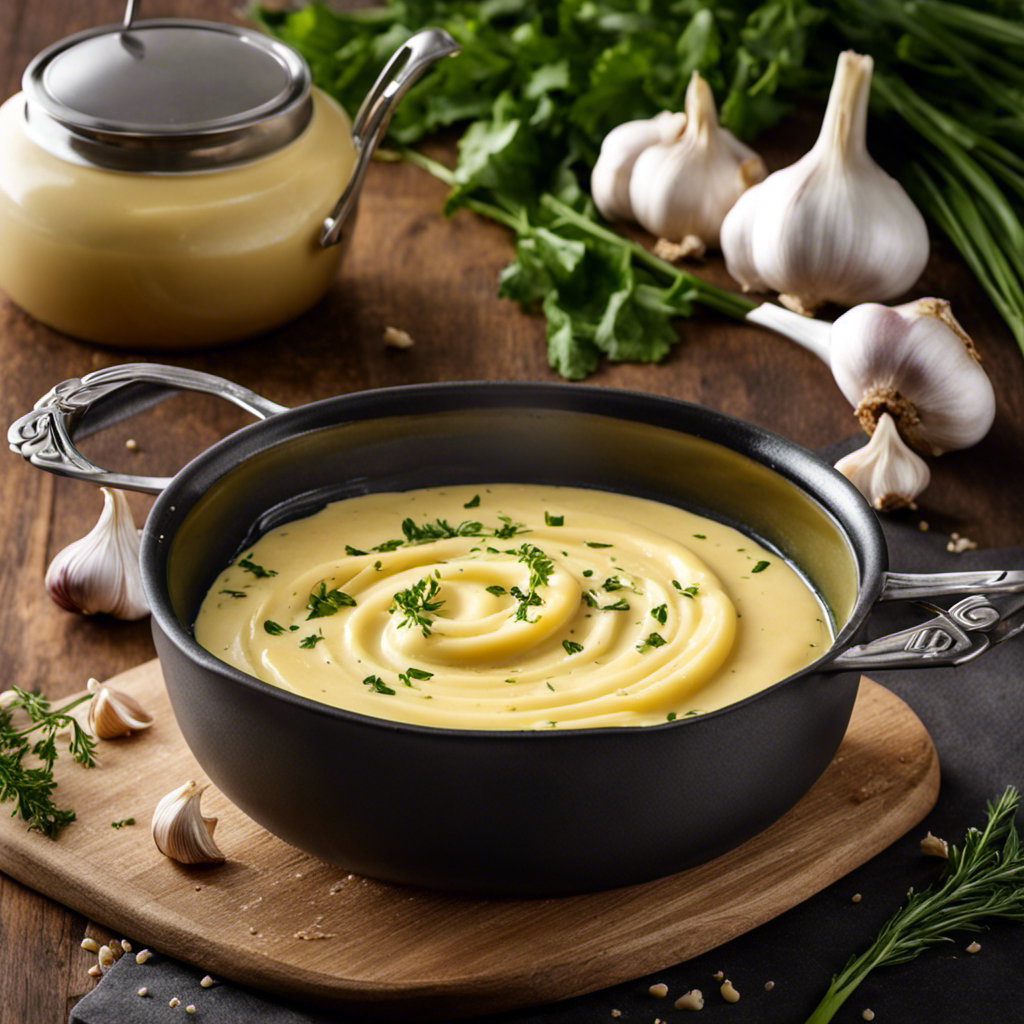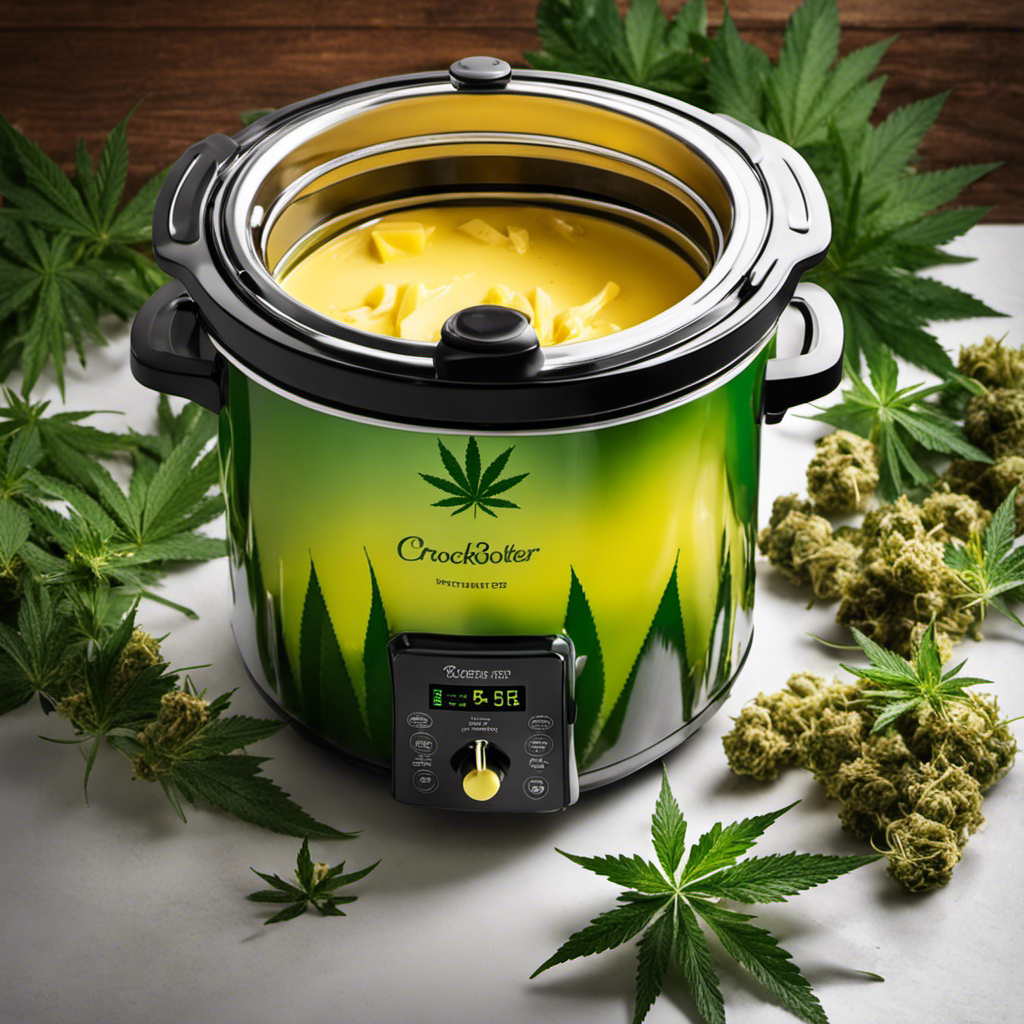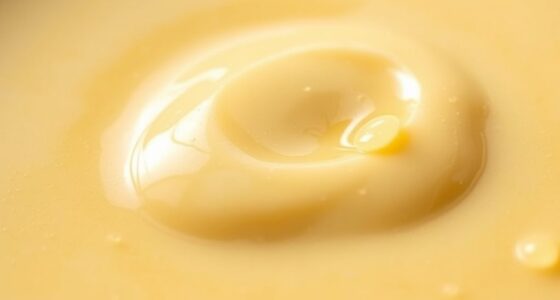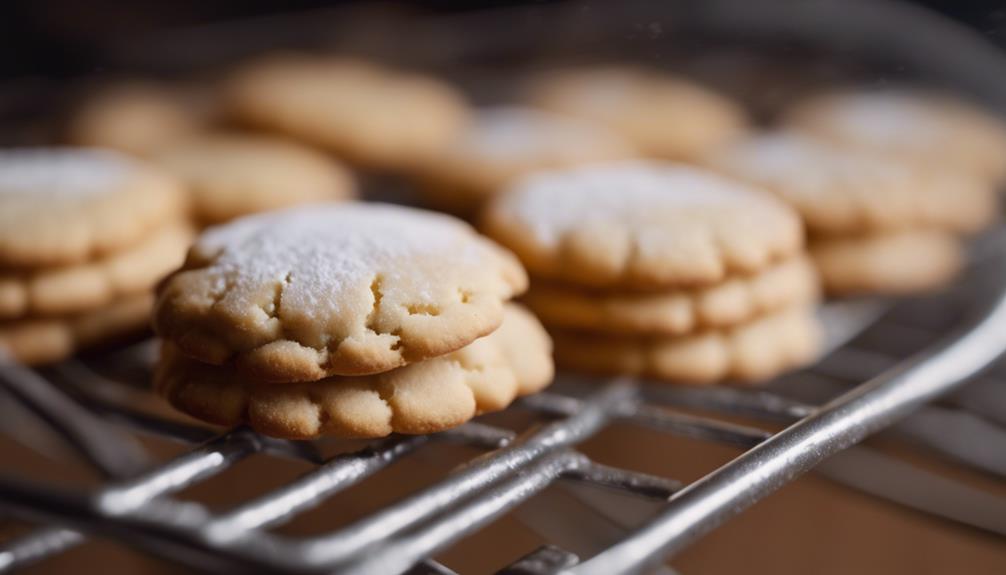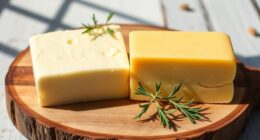Similar to a cozy blanket for your taste buds, garlic butter sauce brings a rich and delicious flavor to every dish.
But what if you prefer a thicker, more indulgent sauce? Fear not, for I am here to guide you through the art of thickening garlic butter sauce.
In this article, I will share my expert techniques and tips to transform your sauce into a creamy masterpiece.
So grab your apron and let’s dive into the world of thick, buttery goodness.
Key Takeaways
- Adding flour or cornstarch creates a velvety texture.
- Simmering the sauce evaporates the liquid, resulting in thickness.
- Roux adds smoothness and thickness to the sauce.
- Cornstarch creates a velvety texture and creaminess.
Understanding the Ingredients
I love using garlic in my cooking, so understanding the ingredients in this garlic butter sauce is important to me.
When it comes to creating a delicious sauce, it’s crucial to have a good understanding of flavor profiles and how to balance acidity. Garlic adds a strong, aromatic flavor to dishes, and when combined with butter, it creates a rich and creamy base.
However, it’s important to note that garlic can be overpowering if not used in moderation. To balance the acidity, adding a touch of lemon juice or white wine vinegar can help cut through the richness and add a bright, tangy note to the sauce.
Techniques for Thickening Garlic Butter Sauce
To achieve a thicker consistency, I can add flour or cornstarch to my garlic butter mixture. These alternative thickening agents work effectively in creating a velvety texture to my sauce.
Additionally, I can experiment with the following techniques to further enhance the thickness of my garlic butter sauce:
- Simmering: By simmering the sauce over low heat, the liquid evaporates, resulting in a thicker consistency.
- Reducing: This involves cooking the sauce for an extended period, allowing it to reduce in volume, thereby thickening it.
- Emulsifying: By slowly adding cold butter to the sauce while whisking vigorously, I can achieve a rich and thickened texture.
- Adding cheese: Incorporating grated or melted cheese into the sauce not only adds flavor but also contributes to a thicker sauce.
- Using a roux: A mixture of equal parts flour and fat, such as butter, can be used as a thickening agent for the sauce.
Using Roux to Thicken Garlic Butter Sauce
Using a roux creates a smooth and thick texture in the sauce. It’s a classic technique that adds richness and depth to the garlic butter sauce.
However, if you’re looking for alternatives to roux or experiencing issues with thickening, there are other techniques you can try.
One option is to use cornstarch or arrowroot powder as a thickening agent. Simply mix either of these with a small amount of cold water to create a slurry, then stir it into the sauce.
Another troubleshooting technique is to reduce the sauce over low heat, allowing the excess liquid to evaporate and the sauce to thicken naturally.
Additionally, you can experiment with adding a small amount of cream or cheese to the sauce, which can contribute to its thickening.
Remember to adjust the seasoning accordingly when using these alternatives or troubleshooting techniques.
Incorporating Cornstarch for a Thick and Creamy Sauce
Incorporating cornstarch creates a velvety texture and adds creaminess to the sauce. It’s one of the alternative thickening agents for garlic butter sauce that can be used to achieve a desired consistency.
Here are some common mistakes to avoid when thickening garlic butter sauce:
-
Using too much cornstarch: Adding excessive cornstarch can result in a glue-like texture, so it’s important to use it sparingly.
-
Not properly dissolving the cornstarch: To prevent lumps, always mix the cornstarch with a small amount of cold liquid before adding it to the sauce.
-
Adding cornstarch to boiling sauce: Cornstarch should be added to a sauce that’s simmering or at a low heat to prevent clumping.
-
Not stirring continuously: Stirring constantly while adding cornstarch ensures even distribution and prevents lumps from forming.
-
Overcooking the sauce: Overcooking can cause the cornstarch to break down and lose its thickening properties, so it’s important to remove the sauce from heat once it has thickened to the desired consistency.
Other Tips and Tricks for Thickening Garlic Butter Sauce
One helpful trick is to slowly whisk in a small amount of flour to achieve a thicker consistency.
However, if you’re looking for alternative thickeners for garlic butter sauce, there are a few options to consider. One option is to use cornstarch, as mentioned in the previous subtopic, but if you’re looking to switch things up, arrowroot powder or tapioca starch can also be used as alternatives. These thickeners work in a similar way to flour or cornstarch, helping to bind the sauce and create a thicker texture.
Another trick to thicken garlic butter sauce is to add cheese. Cheese, particularly grated Parmesan or cream cheese, can be melted into the sauce to not only add flavor but also thicken it. Just be sure to slowly add the cheese while continuously whisking to prevent clumping.
Frequently Asked Questions
How Long Can I Store Garlic Butter Sauce in the Refrigerator?
The shelf life of garlic butter sauce in the refrigerator depends on the preserving methods used. Generally, it can be stored for up to two weeks if properly sealed and kept at a consistent temperature.
To extend its shelf life, consider adding ingredients like lemon juice or vinegar, which can act as natural preservatives.
Always ensure the sauce is stored in a clean and airtight container to prevent spoilage.
Can I Use Olive Oil Instead of Butter in Garlic Butter Sauce?
Using olive oil instead of butter for garlic butter sauce is a great option for those looking to make a vegan version of the sauce. It adds a unique flavor and richness to the dish.
To thicken the sauce, you can try adding a cornstarch slurry or reducing it over low heat. This will help give it a thicker consistency without compromising the taste.
Experiment with different techniques until you find the perfect thickness for your sauce.
Is It Possible to Make Garlic Butter Sauce Without Using Any Dairy Products?
To make a garlic butter sauce without using any dairy products, there are several non-dairy alternatives you can try.
One option is to use a plant-based butter substitute made from oils like coconut or avocado.
Another option is to blend soaked cashews or silken tofu with garlic and seasonings for a creamy texture.
Additionally, you can thicken the sauce by adding a cornstarch slurry or reducing it over low heat.
Experiment with these tips to achieve a delicious non-dairy garlic butter sauce.
Can I Use Arrowroot Powder as a Substitute for Cornstarch in Thickening the Sauce?
Yes, arrowroot powder can be used as a substitute for cornstarch in thickening sauces. It has several benefits such as being gluten-free and a better option for those with allergies or dietary restrictions.
Additionally, there are other alternatives to cornstarch for thickening sauces, such as tapioca starch or potato starch. These substitutes work similarly to cornstarch and can provide the desired thickening effect to your garlic butter sauce.
Are There Any Alternative Methods to Thicken Garlic Butter Sauce Besides Using Roux or Cornstarch?
There are alternative thickeners and methods of emulsifying that can be used to thicken garlic butter sauce, besides using roux or cornstarch. These alternatives can provide different textures and flavors to the sauce.
It’s important to consider the desired outcome and taste when choosing a thickening method. Some options to explore include using egg yolks, heavy cream, or even blending in cooked vegetables like cauliflower or potatoes.
Experimenting with different techniques can lead to delicious and unique results.
Conclusion
In conclusion, by understanding the ingredients and employing various techniques, you can easily thicken your garlic butter sauce to achieve a rich and creamy consistency.
Whether using a roux or incorporating cornstarch, these methods offer excellent results.
Additionally, keep in mind that experimenting with different ratios and temperatures can also contribute to perfecting your sauce.
With these tips and tricks, you’ll be able to elevate your culinary creations to a whole new level.
Enjoy!
